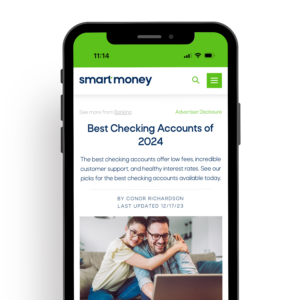Takeaways
- Debit cards are easy-to-use payment cards that limit the need to carry cash.
- Banks, credit unions, or other financial institutions issue debit cards to customers.
- Debit cards can have rewards programs like cash-back offers or special discounts.
- Debit cards are one of the most popular payment cards used for everyday transactions.
- Debit cards can quickly access your cash at ATMs or point-of-sale (POS) machines.
Some of the links in this article are from advertising partners of Smart Money, which does not influence our evaluations or recommendations. We work to provide you with accurate and reliable information. Our opinions are our own.
What is a Debit Card?
A debit card is a payment card issued by your bank, credit union, or other financial institution that links directly to your online checking account. With a debit card, you can make in-person purchases, buy items online, or withdraw cash electronically from an ATM. Debit cards are incredibly easy to use and are widely adopted. In fact, according to the Federal Reserve, over 93% of American adults have a debit card [1].
When you use a debit card, the funds are immediately deducted from your checking account. This differs from a credit card, where the amount spent is charged against a line of credit, allowing you to pay back the amount later.
Today, most debit cards have a magnetic stripe on the back and an NFC chip that will contain encrypted versions of your account information. The front of your card will display your first and last name, card number, and expiration date. However, many cards now print this information on the back for security purposes. Your signature and security code will also be on the back of your debit card.

Member FDIC
Axos Bank® Rewards Checking
Account Type: Free Checking Account
APY: 3.30% with No Minimum Balance
Bonus Offer: Up to $300 Bonus (Terms Apply)
How Does a Debit Card Work?
Debit cards are often evangelized by those who want to avoid debt as the optimal payment card. While you can’t boost your credit score, accrue travel perks, or influence your credit report, a debit card does allow you to spend money you have already saved. Here is a closer look at how a debit card operates:
Transaction Initiation
Debit cards operate much like credit cards in daily use. One of the significant differences is that you are not using debt to pay for your items but cash you have already saved. So, when you purchase online or in person, you will swipe, insert, or tap your debit card to pay. The POS system takes your debit card information, and the transaction details are sent to your bank or payment processor.
Authorization Request
The payment processor checks this information against your bank account to get approval. During this step, the payment processor checks whether you have sufficient funds in your checking account to make the purchase and detect fraud.
Approve or Decline
Your bank will automatically verify your account details and check your available balance. If sufficient funds are available, the transaction will be approved; however, if the funds are not available, the transaction will be declined. Depending on your account, some banks will let you make the purchase and charge an overdraft fee.
Alternatively, if you have linked your checking and savings accounts to your debit card, the bank may pull funds from your online savings account to facilitate the purchase. The payment processor will either approve or decline the transaction.
Completion of Transaction
Once the bank approves the transaction, the merchant can complete the sale. At this point, your bank will hold that amount in your account, reducing your available balance. This process usually takes only a few seconds.
Settlement
At the end of the business day, the merchant will submit all their approved transactions to the bank in batches. The funds are transferred from your bank account to the merchant's account within one to two business days. At this point, the hold placed on your account should show as settled or completed.
Record Keeping
Your bank will record a successful transaction, and you can review it at any point by accessing your bank's online portal, reviewing your bank statement, or calling to check with your bank.
Get Smart With Your Money
Fresh weekly articles delivered straight to your inbox.
Enter your name and email for free tips and tricks.

5 Steps to Applying for a Debit Card
Applying for a debit card should only take a matter of minutes. If you already have an emergency or slush fund you are willing to transfer to a bank or credit union, this could speed up the process. Here are the steps to apply for a new debit card:
1. Select Your Bank or Credit Union
If you do not already have a bank or credit union, then it is time to choose one that fits your needs. Many banks have sign-up promotions, especially if you are able to deposit money into your new account. Review the bank or credit union to see if it supports your needs for today and as your financial needs evolve. For example, check if they offer debit cards, credit cards, auto loans, and mortgages. Once you have selected the best bank, you can navigate to applying for a debit card.
2. Check Eligibility Requirements
Most banks will have specific eligibility requirements for opening a debit card account. These requirements often include a minimum age (usually 18 years old), valid identification, and proof of address. Some banks will also require a minimum deposit to open an account, and if you already have an emergency fund or slush fund, leverage those to your advantage.
3. Apply for an Account
The next order of business is to select the best debit card for you. Some debit cards offer cash-back rewards programs, which can lower your monthly bill, or some other discount programs. Once you select the card you want to apply for, you must prepare to apply. Preparing to apply involves gathering the necessary documents to make this process easier. Most people choose to open an account online, but you can also visit a branch location to begin the process.
4. Provide Your Documents
Once you are on the bank’s website or branch location, you will need to give all of the necessary documentation to open the account. This means providing a government ID, proof of address, social security number, and other information like age, income, and reason for opening the card. This information is used to vet your eligibility and determine if the bank will approve your account.
5. Deposit Funds and Activate Card
Once your account is approved and opened, you need to deposit money into your checking account. You can facilitate this through an online transfer, wire, or check deposit. Once the funds are available in your checking account, your bank will issue you a new debit card. Depending on the bank, most banks will mail you a new card, which usually takes 5-7 business days. Once you receive your card, you will have to activate your debit card by calling a designated phone number in your new debit card package.
Learn More -> How to Open a New Checking Account

Member FDIC
Primis Checking Account
Account Type: Free Checking Account
Required Minimum: $1 to Open
Bonus Offer: Earn 50 Cents for Every Purchase
Advantages of Debit Cards
Debit cards revolutionized the ability to make payments at POS systems and increased the ease of purchase. This was terrific for customers, businesses, and banks. Here are several advantages that make debit cards popular for everyday financial needs:
- Convenience: Debit cards are super convenient because they are small and easily fit into a wallet or purse. Additionally, they eliminate the need to carry large amounts of cash and can even be linked to online payment systems like Venmo or Apply Pay. At this point, almost all retailers accept both debit and credit cards with their POS system.
- Immediate Transactions: Debit cards use funds that are already available. This allows you to manage your monthly expenses effectively and eliminates the ability to get into debt. Debit cards immediately deduct money from your bank account, so there is no bill to pay later and no interest fees, like with credit cards.
- Security: Many banks offer fraud protection with debit cards. If you use your bank’s mobile banking app, you might receive pings when someone is trying to log onto your account, when your card is used atypically, or when fraud has been detected on your account. With fraud prevention, detection, and other security features, carrying a debit card is much safer than carrying cash.
- Budgeting: One of the main advantages of a debit card is that it allows you to seamlessly manage your monthly cash flow. If you have paid off your credit card debt and want to use a debit card to avoid using a line of credit, you can easily automate your finances to deposit funds into your spending account each paycheck. Additionally, you can use apps like Bill Trim with your debit card to help you eliminate recurring subscriptions and other expenses.
Disadvantages of Debit Cards
Depending on your financial situation, spending patterns, and the need to build your credit, debit cards might not be the best payment card for your finances. Here are several disadvantages to debit cards:
- Overdraft Risk: Because spending with a debit card directly withdraws cash from your checking account, you may have to pay overdraft fees if you have insufficient funds. These can be costly and add up if you don't know you have insufficient funds. To help mitigate overdraft fees, you can link your checking and savings account to your debit card. In this case, if you purchase an item that exceeds what is in your checking account, your bank will pull funds from your savings account to avoid fees.
- Limited Fraud Protection: Fraudulent purchases on your debit card work a little differently than on a credit card. Unauthorized transactions on your debit card can immediately impact your checking account, and you will have to call your bank or submit an online ticket for the issue to be resolved. Fraudulent transactions on a credit card are made against your line of credit with the bank or credit union. Thus, there is no immediate impact on your checking or savings account.
- No Credit Building: Many of life’s milestone purchases, like buying a new car, purchasing your first home, or sprucing up your house with a personal loan, require lenders to assess your credit history. This involves a sophisticated evaluation of your credit score. Boosting your credit score by using a credit card can make these larger transactions cost less by securing better terms, interest rates, and reduced fees. Debit cards do not contribute to your credit history because they do not use a line of credit. If you want to increase your credit score, consider applying for a credit card instead.
- Spending Limits: Even though you use funds from your checking account, many banks have daily spending limits. These usually hover around $5,000 but could be inconvenient when you are trying to make large purchases. Credit cards, however, usually only cap purchases up to your approved credit limit.
Smart Summary
Applying for a debit card is a seamless process. Once you select the bank you want to work with, you need to deposit funds in your account, get your debit card, and start making purchases. In our economy, paying with a debit or credit card (and even cryptocurrencies) is par for the course. All you need to focus on is how a debit card can help your budgeting process, control your finances, and curb excessive spending. Setting up the best debit card for you is a smart money move.
(1) Federal Reserve of Atlanta. Payment Card Adoption and Payment Choice. Last Accessed April 24, 2024.











